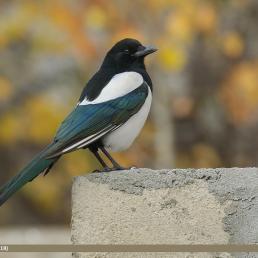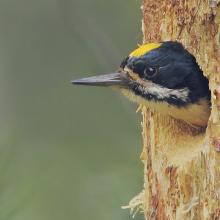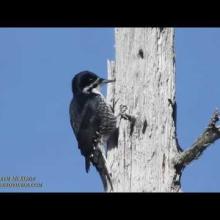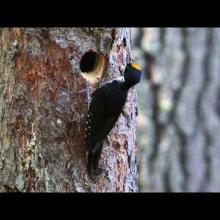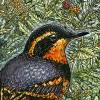

Join BirdNote tomorrow, November 30th!
Illustrator David Sibley and actor H. Jon Benjamin will face off in the bird illustration battle of the century during BirdNote's Year-end Celebration and Auction!
Forest fires have profound effects on birds and other wildlife — for better or worse. Birds such as this Black-backed Woodpecker find a bonanza of insects under burned bark and ample snags in which to carve out nest holes. Woodpecker cavities are often reused by birds like bluebirds. And birds that eat berries perch on branches of dead trees, excreting seeds that help re-grow the shrub layer. In other words, a forest periodically thinned by fire creates hospitable habitat for many species.
Check out this blog about the rejuvenation of a forest.
BirdNote®
Forest Fires, Birds and Recovery
Written by Bob Sundstrom
This is BirdNote.
[Wildfire]
Forest fires have profound effects on birds and other wildlife. In recent years, artificially dense forests — combined with longer and hotter droughts — have created high-intensity fires where all trees are killed, and habitat for all wildlife is drastically reduced. [Wildfire] In the aftermath of fires like these, forest recovery may take generations.
Under natural conditions where fires haven’t been systematically suppressed for decades, forest fires tend be of lower intensity. They clear underbrush and seedlings and leave larger trees alive and standing, and even help their seeds germinate. Often, birds can readily rebound from these kinds of incidents.
[Black-backed Woodpecker drum, http://macaulaylibrary.org/audio/163888] [* See editor's note]
And low-intensity fires can actually increase activity of birds like woodpeckers, which find a bonanza of insects under burned bark and ample snags in which to carve out nest holes.
[Western Bluebird song, http://macaulaylibrary.org/audio/111074]
Last year’s woodpecker cavities are reused in following years by birds like bluebirds. Birds that eat berries perch on branches of dead trees, excreting seeds that help re-grow the shrub layer. In other words, a more open forest periodically thinned by fire makes for a more hospitable habitat for birds and other wildlife.
For BirdNote, I’m Mary McCann.
###
[* Editor's note: One bird species—the Black-backed Woodpecker—is nearly restricted in its distribution to severely burned forests. Even its black back is thought to have evolved to render it invisible against its most frequent environmental backdrop: charcoal black trees. Communication from Richard L. Hutto, Professor Emeritus, Biology and Wildlife Biology, Division of Biological Sciences, University of Montana]
Bird sounds provided by The Macaulay Library of Natural Sounds at the Cornell Lab of Ornithology, Ithaca, New York. Black-backed Woodpecker [163888] recorded by Marshall J Iliff; Western Bluebird [111074] recorded by Thomas G Sander
BirdNote’s theme music was composed and played by Nancy Rumbel and John Kessler
Producer: John Kessler
Executive Producer: Dominic Black
© 2015 Tune In to Nature.org November 2015 Narrator: Mary McCann
ID# fire-01-2015-11-02fire-01
Some background: NY Times article 9/22/15 “After the Burn, an Altered Landscape”
